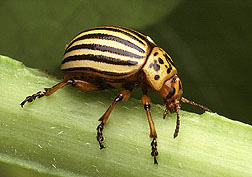Colorado Potato Beetle

They larvae start out small but grow fast, molting four times into larger stages, or instars. The last instars grow to be quite plump, and they’re the ones that eat the most foliage. Then, they crawl into the soil and pupate. From this resting stage, a second generation of adults emerges by the end of the season, ready to eat again before passing the winter underground.
It’s amazing that not long ago, this serious pest of vegetables pest was a harmless, well-behaved insect. It fed only on the buffalo bur, a tough weed that grows along the eastern foothills of the Rocky Mountains. Then, about 150 years ago, the beetles discovered a new food growing in the white man's gardens. It adopted the cultivated potato as its favorite food, spread rapidly, and we’ve been fighting Colorado potato beetles ever since.
It happened like this: with the opening up of the West following the Mormon migration to Utah in1847 and the California gold rush of 1849, pioneers arrived by the thousands and many of them planted potatoes. By 1855 potato growing reached westward to the native home of the beetle, and the insect started to spread eastward along the routes traveled by the pioneers.
By hitchhiking and flying with the prevailing winds, the beetle migrated about 85 miles a year. It reached Nebraska in 1859, Illinois in 1864, Ohio in 1869, and the Atlantic coast in 1874. This caused great alarm overseas, and almost every European country banned the importation of American potatoes. Europe’s potato growing regions remained free of potato beetles until after World War One, when they appeared near Bordeaux, France, where there had been concentrations of American troops and supplies. Now the beetle is widespread in Europe, too.
Resource: Vern Grubinger and Berry Specialist, University of Vermont